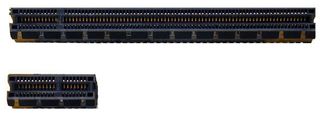Sneak Preview: Intel Alderwood/Grantsdale Chipsets
PCI Express: Up To 8 GB/s

Take a good look at this logo - it will be with us for the years to come.

The fastest and the slowest: x16 PCI Express (top) and x1.
The PCI bus and the AGP interface will be replaced by PCI Express. As opposed to PCI, this involves a serial protocol that can operate all connected devices with the full bandwidth. PCI and PCI-X, by contrast, are parallel busses whose bandwidths are shared by all the devices. In the transition period, PCI Express has the advantage is that it is completely software-compatible to PCI. Apart from this, however, we have determined quite clearly that PCI Express cannot be considered a replacement for PCI-X in the long run. More on this later on.
A single serial connection with PCI Express works with two circuit pairs and a clock speed of 2.5 GHz. Here, a total of 10 bits are transferred for 8 bit data, which results in a total bandwidth of 2 GBit/s and 256 MB/s. Depending on the source line, which is called link or lane, this connection works in full-duplex mode and can therefore send and receive the data simultaneously, and this results in 512 MB/s.
Performance Through Lines
PCI Express was designed to be a scalable interface, so it's not surprising that its faster version is based on multiple lines. The specification is as follows:
| PCI Express Lines | Bandwidth per Stream | Bandwidth, duplex |
|---|---|---|
| 1 | 256 MB/s | 512 MB/s |
| 2 | 512 MB/s | 1 GB/s |
| 4 | 1 GB/s | 2 GB/s |
| 8 | 2 GB/s | 4 GB/s |
| 16 | 4 GB/s | 8 GB/s |
| 32* | 8 GB/s | 16 GB/s |
* Not specified for desktop use

Above is a typical PCI slot, below is a x16 PCI Express slot.
Stay on the Cutting Edge
Join the experts who read Tom's Hardware for the inside track on enthusiast PC tech news — and have for over 25 years. We'll send breaking news and in-depth reviews of CPUs, GPUs, AI, maker hardware and more straight to your inbox.
Current page: PCI Express: Up To 8 GB/s
Prev Page A Quick Start: Corsair CM2X512 Next Page PCI Express Graphics Cards